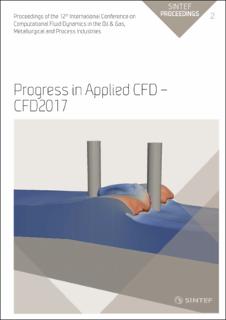| dc.contributor.author | Dang, Son Tung | |
| dc.contributor.author | Johansen, Stein Tore | |
| dc.contributor.author | Meese, Ernst A. | |
| dc.date.accessioned | 2020-12-21T08:23:20Z | |
| dc.date.available | 2020-12-21T08:23:20Z | |
| dc.date.created | 2018-01-27T15:14:26Z | |
| dc.date.issued | 2017 | |
| dc.identifier.citation | Progress in Applied CFD – CFD2017 Selected papers from 12th International Conference on Computational Fluid Dynamics in the Oil & Gas, Metallurgical and Process Industries | en_US |
| dc.identifier.isbn | 978-82-536-1544-8 | |
| dc.identifier.uri | https://hdl.handle.net/11250/2720462 | |
| dc.description.abstract | Simulation of multiphase flows are generally treated by various classes of Eulerian methods, Lagrangian methods and various combinations of these. In the SIMCOFLOW initiative we have set out to develop a framework for simulation of multi-material flows, using an Eulerian description. A fundamental part is the application of Cartesian grids with cut cells, and with a staggered representation of the grid for velocities and scalars. The model equations are derived based on formal volume and ensemble averaging (Gray and Lee, 1977; Quintard and Whitaker, 1995; Cushman, 1982). Solid walls or moving solid materials are treated in the same manner as any flowing material (fluid, deforming material). The interface is characterized by a level set or by a 3D surface. In grid cells which are cut with a large scale interface the stress acting at the cut surface can be computed based on the level set or volume fractions. The exchange of mass, energy and momentum between continuous fluids (note: walls are also considered a continuous fluid) can be estimated by wall functions in the case of coarse grids. The methods applied to the flow in a general geometry is closely related to the FAVOR method (Hirt and Sicilian, 1985), the LSSTAG method (Cheny and Botella, 2010) and the cut-cell method of (Kirkpatrick et al., 2003). In this paper we present the derived equations and applications of the method to a single phase two-dimensional flow, and where solid walls are treated as a non-moving secondary phase. Simulations are performed for flow over a cylinder in crossflow. Simulation results are compared with experiments from literature. The results are discussed and critical issues are pointed out. | en_US |
| dc.language.iso | eng | en_US |
| dc.publisher | SINTEF akademisk forlag | en_US |
| dc.relation.ispartof | Progress in Applied CFD – CFD2017 Selected papers from 12th International Conference on Computational Fluid Dynamics in the Oil & Gas, Metallurgical and Process Industries | |
| dc.relation.ispartofseries | SINTEF proceedings;2387-4295 | |
| dc.rights | Attribution-NonCommercial-NoDerivatives 4.0 Internasjonal | * |
| dc.rights.uri | http://creativecommons.org/licenses/by-nc-nd/4.0/deed.no | * |
| dc.subject | Level-set | en_US |
| dc.subject | immersed boundary method | en_US |
| dc.subject | Cut-Cell | en_US |
| dc.subject | Cartesian grid | en_US |
| dc.subject | CFD | en_US |
| dc.title | A cartesian cut-cell method, based on formal volume averaging of mass, momentum equations | en_US |
| dc.type | Chapter | en_US |
| dc.type | Peer reviewed | en_US |
| dc.description.version | publishedVersion | en_US |
| dc.rights.holder | SINTEF Proceedings er Open Access etter CC BY-NC-ND-lisensen (http://creativecommons.org/licenses/by-nc-nd/4.0/). | en_US |
| dc.source.pagenumber | 265-271 | en_US |
| dc.identifier.cristin | 1553407 | |
| cristin.unitcode | 7401,80,0,0 | |
| cristin.unitname | SINTEF Materialer og kjemi | |
| cristin.ispublished | true | |
| cristin.fulltext | original | |

